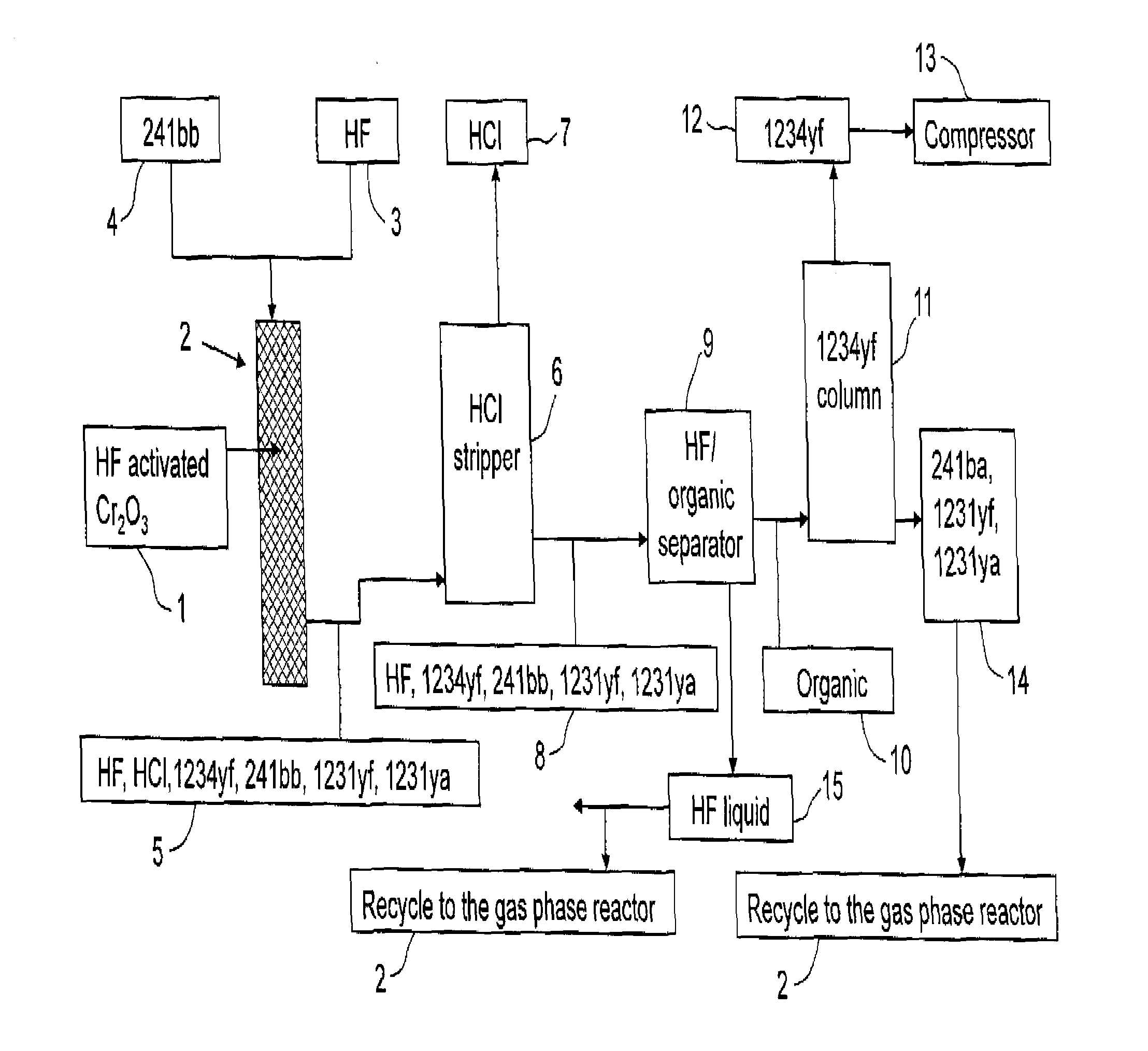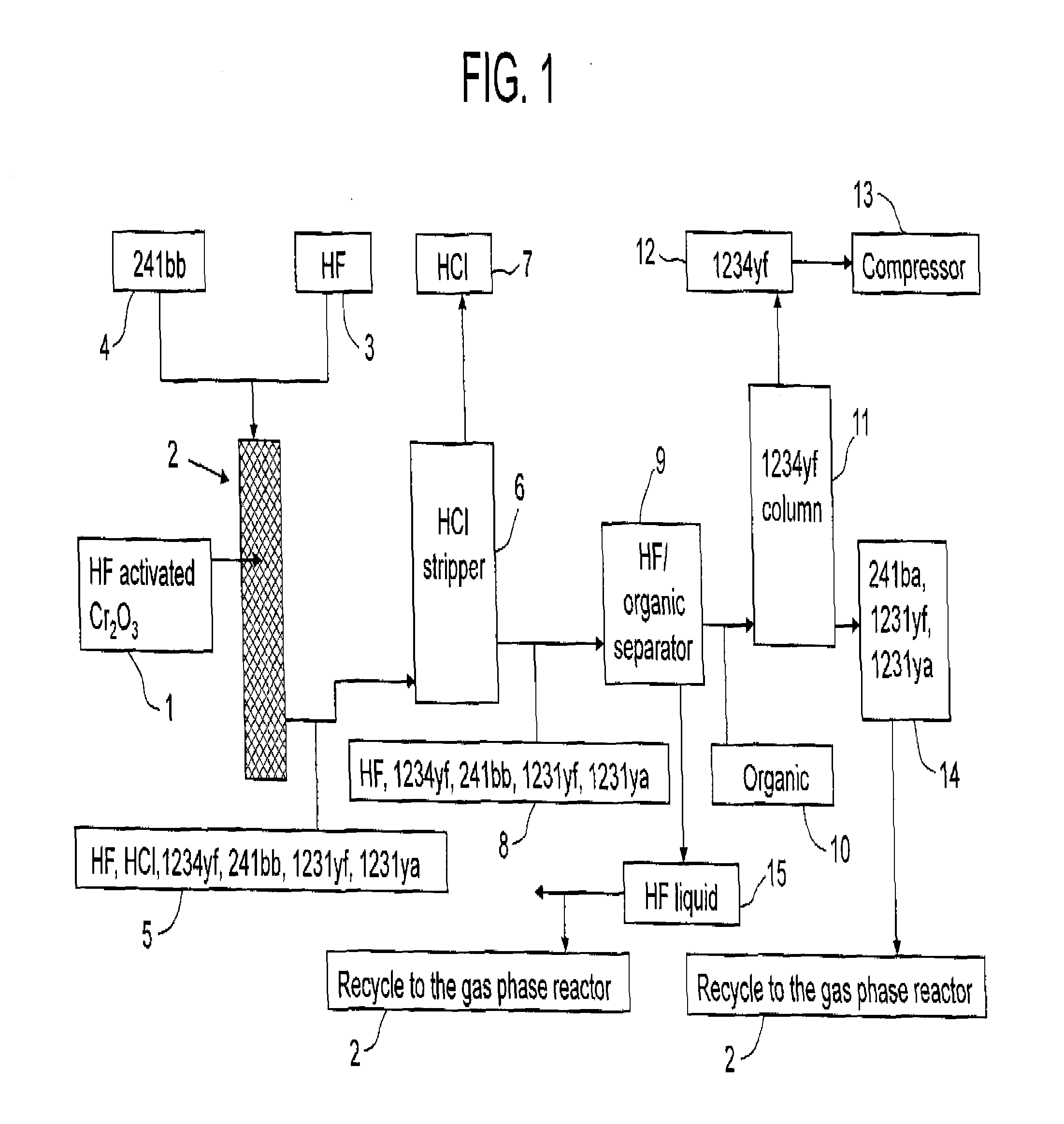Process for the manufacture of tetrafluoroolefins
a technology of tetrafluoroolefin and process, which is applied in the field of making tetrafluoroolefin, can solve the problems of complex multi-step processes, and high cost of custom-made catalysts, and achieves good selectivity and high conversion.
- Summary
- Abstract
- Description
- Claims
- Application Information
AI Technical Summary
Benefits of technology
Problems solved by technology
Method used
Image
Examples
##ic example 1
Prophetic Example 1
Catalytic Dehydrochlorination of 1,2,3-Trichloropropane to 1250xf
[0078]The dehydrochlorination of CH2ClCHClCH2Cl (1,2,3-trichloropropane) to CH2═CCl(CH2Cl) (1250xf) may be carried out using a fixed bed reactor fitted into an organic gas inlet. The reactor may be heated up electrically using a three-zone furnace. After loading the catalyst (e.g., 20 CC of 5 weight % anhydrous FeCl3 supported on activated carbon (e.g., CALGON CPG, which is an activated carbon obtainable from Calgon Carbon Corp. with offices in Pittsburgh, Pa.)). Organic feedstock may be fed using a pump at a feed rate, e.g., corresponding to about 20 seconds contact time, and at atmospheric pressure. The organic product may be scrubbed of HCl gas and dried using anhydrous CaSO4. It is estimated that conversion would be about 12% and selectivity of 1250xf would be about 98%.
##ic example 2
Prophetic Example 2
Aqueous Dehydrochlorination of 1,2,3-Trichloropropane to 1250xf
[0079]1,2,3-trichloropropane (HCC-260da) (e.g., 100 g, 0.678 mole) may be placed in a three necked round bottomed flask, equipped with a 250 ml dropping funnel, water condenser, and mechanical stirrer. Sodium hydroxide aqueous solution (e.g., 115 ml; 0.006 mol / ml) may be added drop wise, with continuous stirring at about 80° C. After complete addition, the reaction mixture may be stirred further at 80° C. for an additional ½ hour. The organic layer may then be separated and dried over anhydrous CaSO4. The dry organic product may be redistilled to produce about 65 grams (e.g., about 86% yield and 99% purity 1250xf).
##ic examples 3-5
Prophetic Examples 3-5
Liquid Phase Fluorination of 1250xf to 261bb
[0080]The liquid phase fluorination of CH2═CCl(CH2Cl) (1250xf)+HF→CH3CFClCH2Cl (261bb) may be carried out as follows. A 500 CC autoclave may be fitted with a mechanical stirrer, low temperature condenser, liquid organic inlet, HF gas inlet, catalyst inlet, nitrogen gas inlet, and product outlet. HF (e.g., 200 grams, 10 moles) may be introduced into the autoclave together with the titanium tetrachloride TiCl4 (e.g., 10 g, 0.053 moles). The mixture may be stirred at room temperature for about ½ hour. The HCl gas may be released and the organic feed 1250xf (e.g., 100 g, 0.9 moles) may be introduced into the reactor. The reaction mixture may be stirred for about 2 hours at 60° C. The HCl gas may be vented. Nitrogen gas (e.g., 40 cm3 / m) may be introduced into the reaction mixture. The organic product may be collected in a receiver that has been pre-cooled in a dry ice acetone trap. The product obtained may be about 80 gram...
PUM
| Property | Measurement | Unit |
|---|---|---|
| Temperature | aaaaa | aaaaa |
| Fraction | aaaaa | aaaaa |
| Fraction | aaaaa | aaaaa |
Abstract
Description
Claims
Application Information
 Login to View More
Login to View More - R&D
- Intellectual Property
- Life Sciences
- Materials
- Tech Scout
- Unparalleled Data Quality
- Higher Quality Content
- 60% Fewer Hallucinations
Browse by: Latest US Patents, China's latest patents, Technical Efficacy Thesaurus, Application Domain, Technology Topic, Popular Technical Reports.
© 2025 PatSnap. All rights reserved.Legal|Privacy policy|Modern Slavery Act Transparency Statement|Sitemap|About US| Contact US: help@patsnap.com



